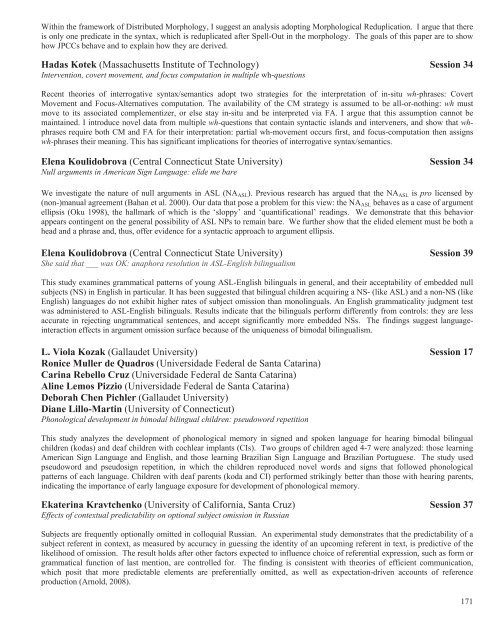here - Linguistic Society of America
here - Linguistic Society of America
here - Linguistic Society of America
Create successful ePaper yourself
Turn your PDF publications into a flip-book with our unique Google optimized e-Paper software.
Within the framework <strong>of</strong> Distributed Morphology, I suggest an analysis adopting Morphological Reduplication. I argue that t<strong>here</strong>is only one predicate in the syntax, which is reduplicated after Spell-Out in the morphology. The goals <strong>of</strong> this paper are to showhow JPCCs behave and to explain how they are derived.Hadas Kotek (Massachusetts Institute <strong>of</strong> Technology) Session 34Intervention, covert movement, and focus computation in multiple wh-questionsRecent theories <strong>of</strong> interrogative syntax/semantics adopt two strategies for the interpretation <strong>of</strong> in-situ wh-phrases: CovertMovement and Focus-Alternatives computation. The availability <strong>of</strong> the CM strategy is assumed to be all-or-nothing: wh mustmove to its associated complementizer, or else stay in-situ and be interpreted via FA. I argue that this assumption cannot bemaintained. I introduce novel data from multiple wh-questions that contain syntactic islands and interveners, and show that whphrasesrequire both CM and FA for their interpretation: partial wh-movement occurs first, and focus-computation then assignswh-phrases their meaning. This has significant implications for theories <strong>of</strong> interrogative syntax/semantics.Elena Koulidobrova (Central Connecticut State University) Session 34Null arguments in <strong>America</strong>n Sign Language: elide me bareWe investigate the nature <strong>of</strong> null arguments in ASL (NA ASL ). Previous research has argued that the NA ASL is pro licensed by(non-)manual agreement (Bahan et al. 2000). Our data that pose a problem for this view: the NA ASL behaves as a case <strong>of</strong> argumentellipsis (Oku 1998), the hallmark <strong>of</strong> which is the ‘sloppy’ and ‘quantificational’ readings. We demonstrate that this behaviorappears contingent on the general possibility <strong>of</strong> ASL NPs to remain bare. We further show that the elided element must be both ahead and a phrase and, thus, <strong>of</strong>fer evidence for a syntactic approach to argument ellipsis.Elena Koulidobrova (Central Connecticut State University) Session 39She said that ___ was OK: anaphora resolution in ASL-English bilingualismThis study examines grammatical patterns <strong>of</strong> young ASL-English bilinguals in general, and their acceptability <strong>of</strong> embedded nullsubjects (NS) in English in particular. It has been suggested that bilingual children acquiring a NS- (like ASL) and a non-NS (likeEnglish) languages do not exhibit higher rates <strong>of</strong> subject omission than monolinguals. An English grammaticality judgment testwas administered to ASL-English bilinguals. Results indicate that the bilinguals perform differently from controls: they are lessaccurate in rejecting ungrammatical sentences, and accept significantly more embedded NSs. The findings suggest languageinteractioneffects in argument omission surface because <strong>of</strong> the uniqueness <strong>of</strong> bimodal bilingualism.L. Viola Kozak (Gallaudet University) Session 17Ronice Muller de Quadros (Universidade Federal de Santa Catarina)Carina Rebello Cruz (Universidade Federal de Santa Catarina)Aline Lemos Pizzio (Universidade Federal de Santa Catarina)Deborah Chen Pichler (Gallaudet University)Diane Lillo-Martin (University <strong>of</strong> Connecticut)Phonological development in bimodal bilingual children: pseudoword repetitionThis study analyzes the development <strong>of</strong> phonological memory in signed and spoken language for hearing bimodal bilingualchildren (kodas) and deaf children with cochlear implants (CIs). Two groups <strong>of</strong> children aged 4-7 were analyzed: those learning<strong>America</strong>n Sign Language and English, and those learning Brazilian Sign Language and Brazilian Portuguese. The study usedpseudoword and pseudosign repetition, in which the children reproduced novel words and signs that followed phonologicalpatterns <strong>of</strong> each language. Children with deaf parents (koda and CI) performed strikingly better than those with hearing parents,indicating the importance <strong>of</strong> early language exposure for development <strong>of</strong> phonological memory.Ekaterina Kravtchenko (University <strong>of</strong> California, Santa Cruz) Session 37Effects <strong>of</strong> contextual predictability on optional subject omission in RussianSubjects are frequently optionally omitted in colloquial Russian. An experimental study demonstrates that the predictability <strong>of</strong> asubject referent in context, as measured by accuracy in guessing the identity <strong>of</strong> an upcoming referent in text, is predictive <strong>of</strong> thelikelihood <strong>of</strong> omission. The result holds after other factors expected to influence choice <strong>of</strong> referential expression, such as form orgrammatical function <strong>of</strong> last mention, are controlled for. The finding is consistent with theories <strong>of</strong> efficient communication,which posit that more predictable elements are preferentially omitted, as well as expectation-driven accounts <strong>of</strong> referenceproduction (Arnold, 2008).171
















